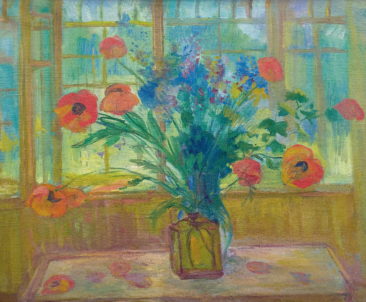

Pavel Varfolomeevich Kuznetsov is one of the most interesting painters of the first half of the 20th century.
He was born in Saratov in the family of an icon painter. When the artistic inclinations of the boy were clearly defined, he entered the “Painting and Drawing Studio” under the Saratov Society of Fine Arts Lovers.
The artist entered the Moscow School of Painting, Sculpture and Architecture in 1897. The study gave a circle of friends and like-minded people who later formed the artistic association “Blue Rose”.
Artistic gift was combined in Kuznetsov with inexhaustible energy of the soul, after all, expressed in the amazing creative longevity of a world-class master. He collaborated with editions of the Symbolist trend: magazines “Art”, “Golden Fleece”, and also was a member of the “World of Art”.
In 1904 Pavel Kuznetsov became one of the organizers of the exhibition “The Scarlet Rose”, and also took an active part in the formation of the artistic association “Blue Rose”. In 1906, the artist, at the invitation of Sergei Diaghilev, went to Paris, where he attended private art studios. His work took part in the exhibition of Russian art, according to which Kuznetsov was elected a member of the Autumn Salon. However, at the end of the 1900s the painter’s work was in crisis, repetitions began, and it seemed that the master had exhausted himself. But having undertaken trips to the Zavolzhsky steppes in 1911-1912 and Central Asia in 1912-1913, Kuznetsov’s work again skyrocketed, even higher than during the period of activity in the association “Blue Rose”. Also, the painter had the experience of a mentor. In the 1917-18’s. Kuznetsov taught at the Stroganov Art and Industrial School.
Everyone who knew Pavel Kuznetsov noted his amazing ability to always see the space of the picture as a whole. He often reinterpreted dreams and dreams that mingled with reality. Plane-linear rhythms, flickering coloring created an analogy with musical, literary symbolism. In the paintings of the so-called “steppe” or Kirghiz series the artist skillfully combined decorative generalization and a thin gradation of color shades. The master always inclined to monumentality and even tried to use in his easel paintings the technique of wall paintings, in particular seco. In his works there is poetry and dynamics, they are full of air and light. And although there is nothing defiant in them, they are very original, not ordinary. Immediately striking is the independence of color relationships, color, tone, etc.
In 1947, Kuznetsov returned to teaching at the Stroganov School, where he was appointed the head of the Department of Monumental Painting. In recent decades, he painted many landscapes, still lifes and portraits from nature. He especially loved the Baltic States.
“The definition of dark and light, the relationship of medium tones – as in music: tones, halftones, high notes, low. Canvas should live in a richness of inherent characteristics, visual attention … “said Pavel Kuznetsov to his students, and this was his artistic credo throughout his life.
A well-known painter died on February 21, 1968. In the Voronezh Regional Art Museum. I.N. Kramskoy presented his work “Still Life with Poppies.”
Image: P.V. Kuznetsov. Still life with poppies. 1940